BA (Hons) Business Project: Amazon.com Company Analysis and Strategy
VerifiedAdded on 2020/05/28
|26
|7392
|89
Report
AI Summary
This comprehensive report undertakes a thorough analysis of Amazon.com, examining its company environment and competitive position within the e-commerce landscape. It begins with an introduction to Amazon's history, business models, and global presence, highlighting its evolution from an online bookstore to a dominant e-commerce player. The report then delves into a comparative analysis between Amazon and Alibaba, exploring their competitive strategies, business models, and geographical focus. Furthermore, it investigates Amazon's competitive advantages, challenges, and strategies for enhancing its business, including the use of data, brand experience, loyalty programs, and diversification. The report also incorporates a PESTLE analysis to assess the macro-environmental factors impacting Amazon's operations. Finally, it concludes with recommendations for Amazon to maintain its competitive edge in the rapidly evolving e-commerce market.
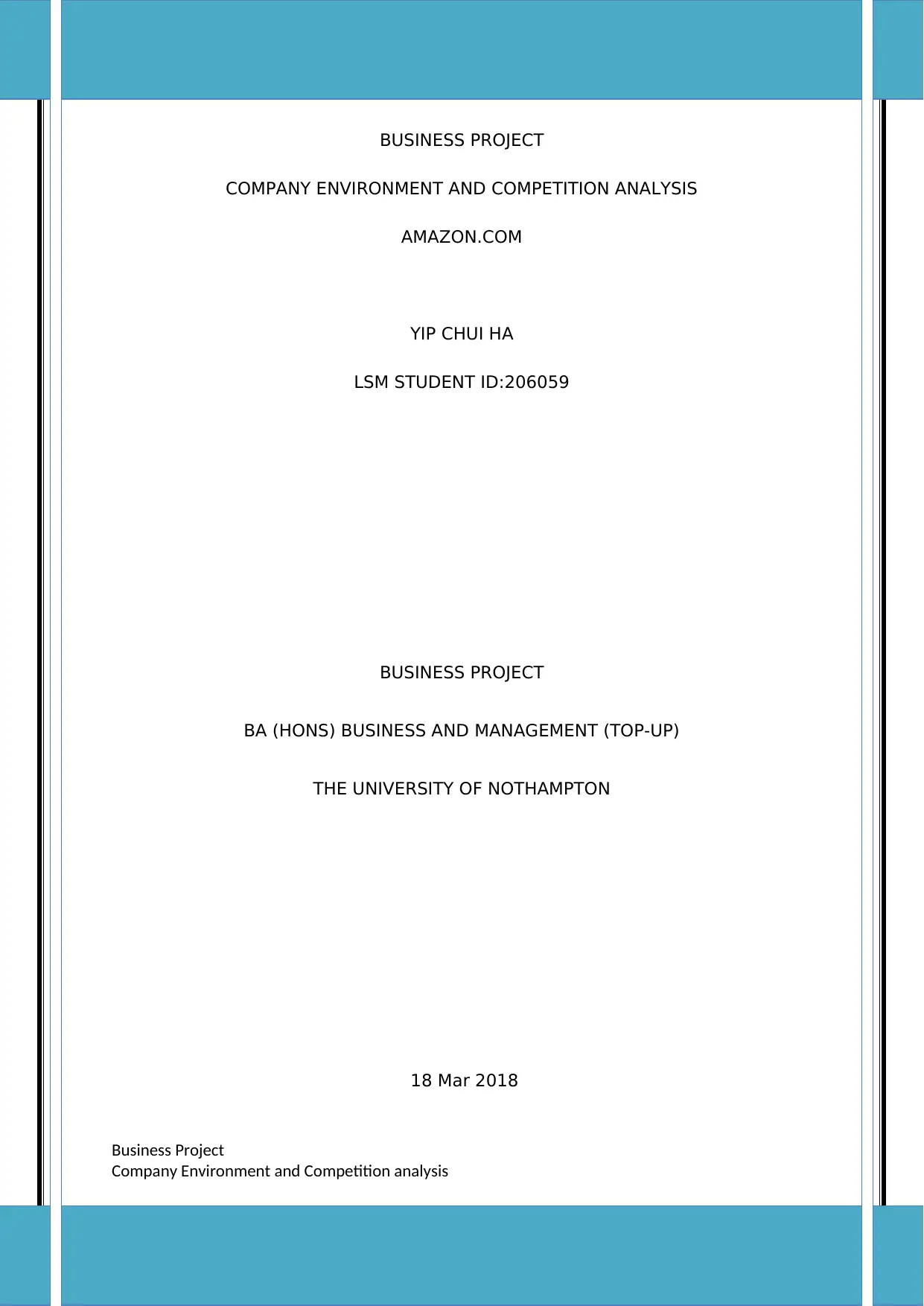
BUSINESS PROJECT
COMPANY ENVIRONMENT AND COMPETITION ANALYSIS
AMAZON.COM
YIP CHUI HA
LSM STUDENT ID:206059
BUSINESS PROJECT
BA (HONS) BUSINESS AND MANAGEMENT (TOP-UP)
THE UNIVERSITY OF NOTHAMPTON
18 Mar 2018
Business Project
Company Environment and Competition analysis
COMPANY ENVIRONMENT AND COMPETITION ANALYSIS
AMAZON.COM
YIP CHUI HA
LSM STUDENT ID:206059
BUSINESS PROJECT
BA (HONS) BUSINESS AND MANAGEMENT (TOP-UP)
THE UNIVERSITY OF NOTHAMPTON
18 Mar 2018
Business Project
Company Environment and Competition analysis
Paraphrase This Document
Need a fresh take? Get an instant paraphrase of this document with our AI Paraphraser

Running Head: Business Project P a g e | 1
Amazon.com
Amazon.com
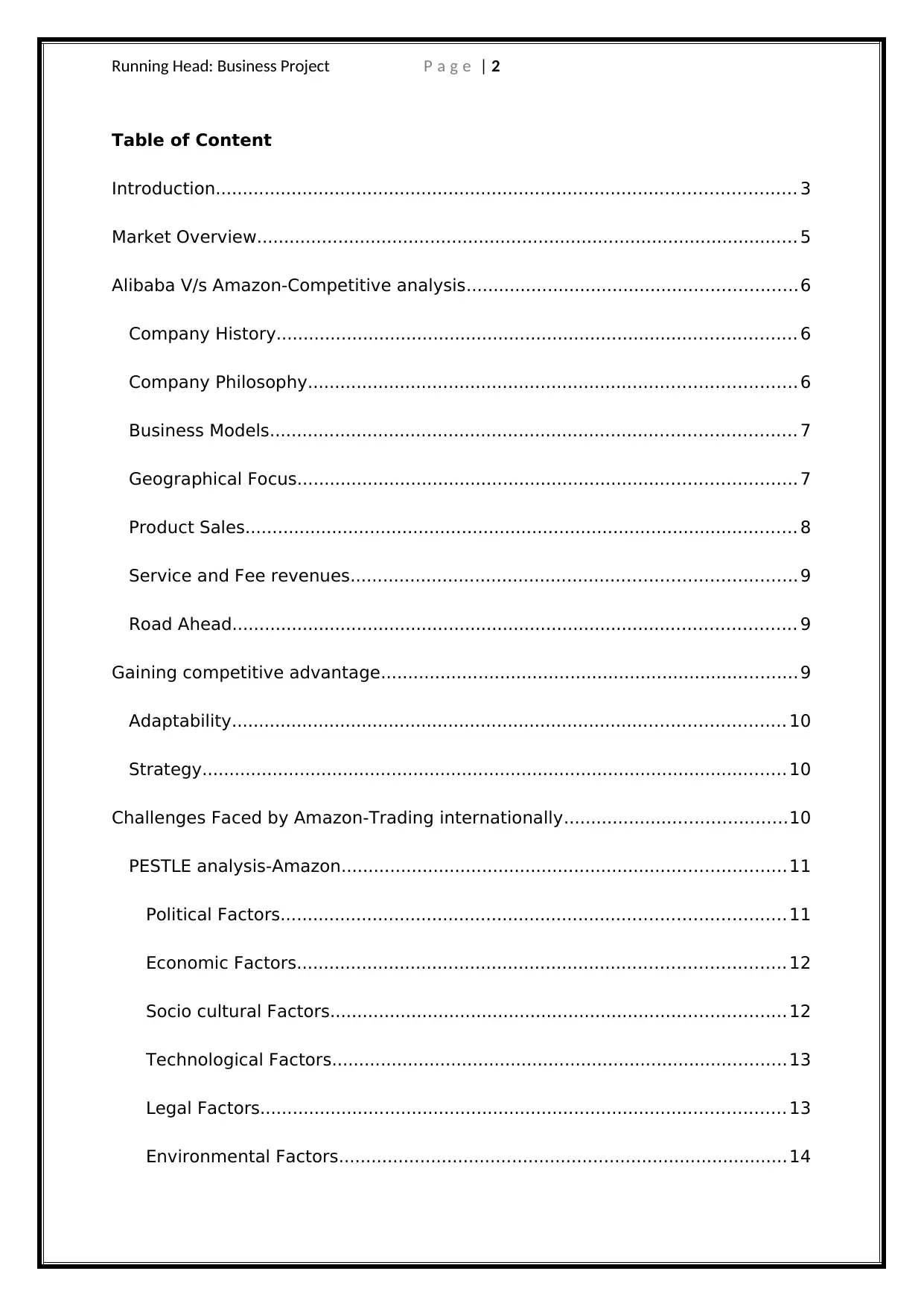
Running Head: Business Project P a g e | 2
Table of Content
Introduction........................................................................................................... 3
Market Overview.................................................................................................... 5
Alibaba V/s Amazon-Competitive analysis.............................................................6
Company History................................................................................................ 6
Company Philosophy.......................................................................................... 6
Business Models................................................................................................. 7
Geographical Focus............................................................................................ 7
Product Sales...................................................................................................... 8
Service and Fee revenues..................................................................................9
Road Ahead........................................................................................................ 9
Gaining competitive advantage.............................................................................9
Adaptability...................................................................................................... 10
Strategy............................................................................................................ 10
Challenges Faced by Amazon-Trading internationally.........................................10
PESTLE analysis-Amazon..................................................................................11
Political Factors............................................................................................. 11
Economic Factors.......................................................................................... 12
Socio cultural Factors.................................................................................... 12
Technological Factors....................................................................................13
Legal Factors................................................................................................. 13
Environmental Factors...................................................................................14
Table of Content
Introduction........................................................................................................... 3
Market Overview.................................................................................................... 5
Alibaba V/s Amazon-Competitive analysis.............................................................6
Company History................................................................................................ 6
Company Philosophy.......................................................................................... 6
Business Models................................................................................................. 7
Geographical Focus............................................................................................ 7
Product Sales...................................................................................................... 8
Service and Fee revenues..................................................................................9
Road Ahead........................................................................................................ 9
Gaining competitive advantage.............................................................................9
Adaptability...................................................................................................... 10
Strategy............................................................................................................ 10
Challenges Faced by Amazon-Trading internationally.........................................10
PESTLE analysis-Amazon..................................................................................11
Political Factors............................................................................................. 11
Economic Factors.......................................................................................... 12
Socio cultural Factors.................................................................................... 12
Technological Factors....................................................................................13
Legal Factors................................................................................................. 13
Environmental Factors...................................................................................14
⊘ This is a preview!⊘
Do you want full access?
Subscribe today to unlock all pages.

Trusted by 1+ million students worldwide

Running Head: Business Project P a g e | 3
Other challenges faced by Amazon..................................................................14
Logistics........................................................................................................ 14
Cultural complexities..................................................................................... 14
Language barriers and communication styles...............................................15
Cost calculation and Global pricing strategy.................................................15
Strategy for Amazon to enhance the business....................................................16
Usage of Data to upsell.................................................................................... 16
Enhanced brand experience for the consumers...............................................16
A loyalty program with serious benefits...........................................................16
Google Ad’s...................................................................................................... 16
Diversify into cloud based business..................................................................17
Amazon marketing communications................................................................17
Amazon Partnership strategy...........................................................................17
Data driven automation.................................................................................... 17
Focus on Artificial intelligence and machine learning.......................................18
Conclusion........................................................................................................... 18
References........................................................................................................... 20
Other challenges faced by Amazon..................................................................14
Logistics........................................................................................................ 14
Cultural complexities..................................................................................... 14
Language barriers and communication styles...............................................15
Cost calculation and Global pricing strategy.................................................15
Strategy for Amazon to enhance the business....................................................16
Usage of Data to upsell.................................................................................... 16
Enhanced brand experience for the consumers...............................................16
A loyalty program with serious benefits...........................................................16
Google Ad’s...................................................................................................... 16
Diversify into cloud based business..................................................................17
Amazon marketing communications................................................................17
Amazon Partnership strategy...........................................................................17
Data driven automation.................................................................................... 17
Focus on Artificial intelligence and machine learning.......................................18
Conclusion........................................................................................................... 18
References........................................................................................................... 20
Paraphrase This Document
Need a fresh take? Get an instant paraphrase of this document with our AI Paraphraser
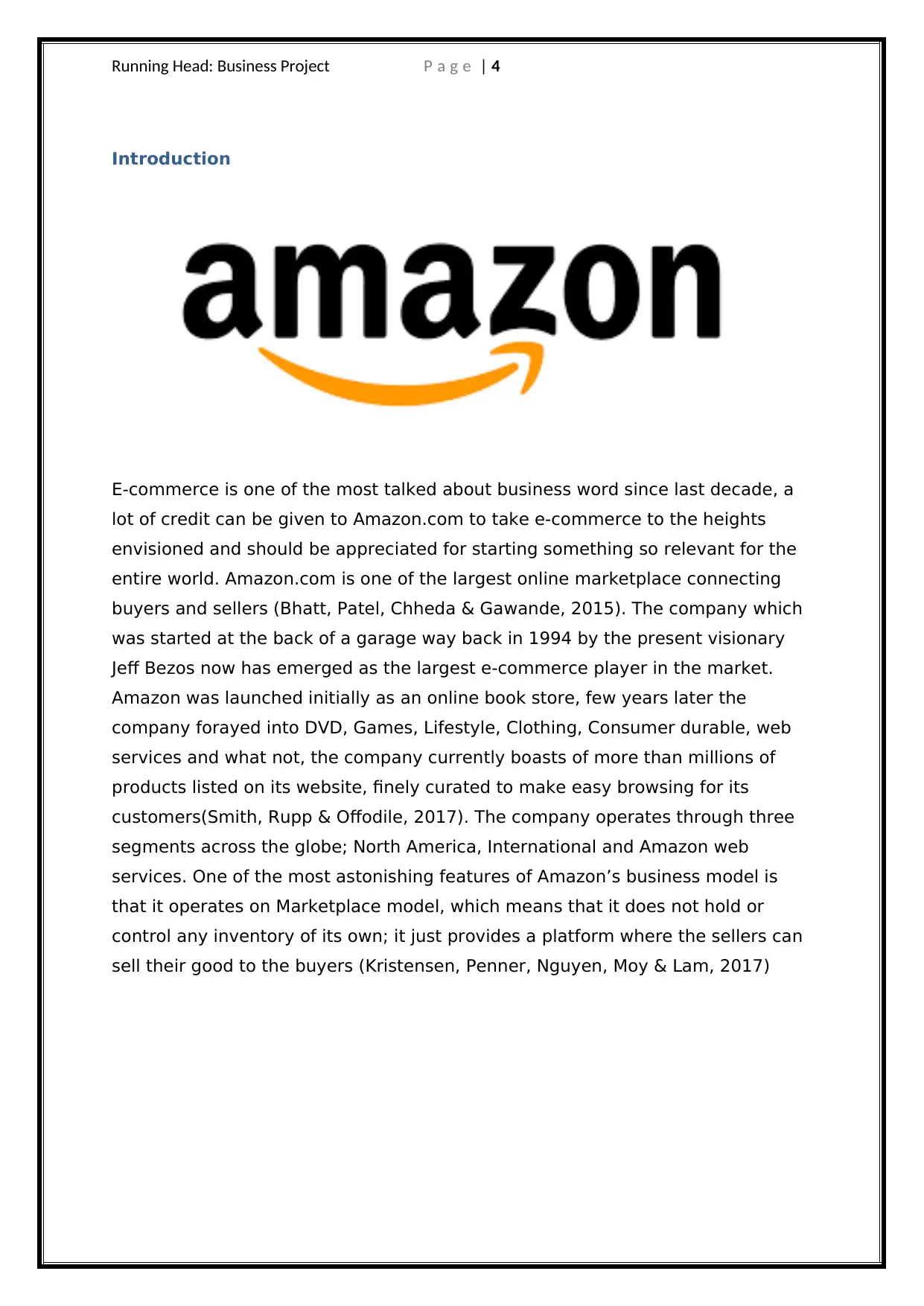
Running Head: Business Project P a g e | 4
Introduction
E-commerce is one of the most talked about business word since last decade, a
lot of credit can be given to Amazon.com to take e-commerce to the heights
envisioned and should be appreciated for starting something so relevant for the
entire world. Amazon.com is one of the largest online marketplace connecting
buyers and sellers (Bhatt, Patel, Chheda & Gawande, 2015). The company which
was started at the back of a garage way back in 1994 by the present visionary
Jeff Bezos now has emerged as the largest e-commerce player in the market.
Amazon was launched initially as an online book store, few years later the
company forayed into DVD, Games, Lifestyle, Clothing, Consumer durable, web
services and what not, the company currently boasts of more than millions of
products listed on its website, finely curated to make easy browsing for its
customers(Smith, Rupp & Offodile, 2017). The company operates through three
segments across the globe; North America, International and Amazon web
services. One of the most astonishing features of Amazon’s business model is
that it operates on Marketplace model, which means that it does not hold or
control any inventory of its own; it just provides a platform where the sellers can
sell their good to the buyers (Kristensen, Penner, Nguyen, Moy & Lam, 2017)
Introduction
E-commerce is one of the most talked about business word since last decade, a
lot of credit can be given to Amazon.com to take e-commerce to the heights
envisioned and should be appreciated for starting something so relevant for the
entire world. Amazon.com is one of the largest online marketplace connecting
buyers and sellers (Bhatt, Patel, Chheda & Gawande, 2015). The company which
was started at the back of a garage way back in 1994 by the present visionary
Jeff Bezos now has emerged as the largest e-commerce player in the market.
Amazon was launched initially as an online book store, few years later the
company forayed into DVD, Games, Lifestyle, Clothing, Consumer durable, web
services and what not, the company currently boasts of more than millions of
products listed on its website, finely curated to make easy browsing for its
customers(Smith, Rupp & Offodile, 2017). The company operates through three
segments across the globe; North America, International and Amazon web
services. One of the most astonishing features of Amazon’s business model is
that it operates on Marketplace model, which means that it does not hold or
control any inventory of its own; it just provides a platform where the sellers can
sell their good to the buyers (Kristensen, Penner, Nguyen, Moy & Lam, 2017)
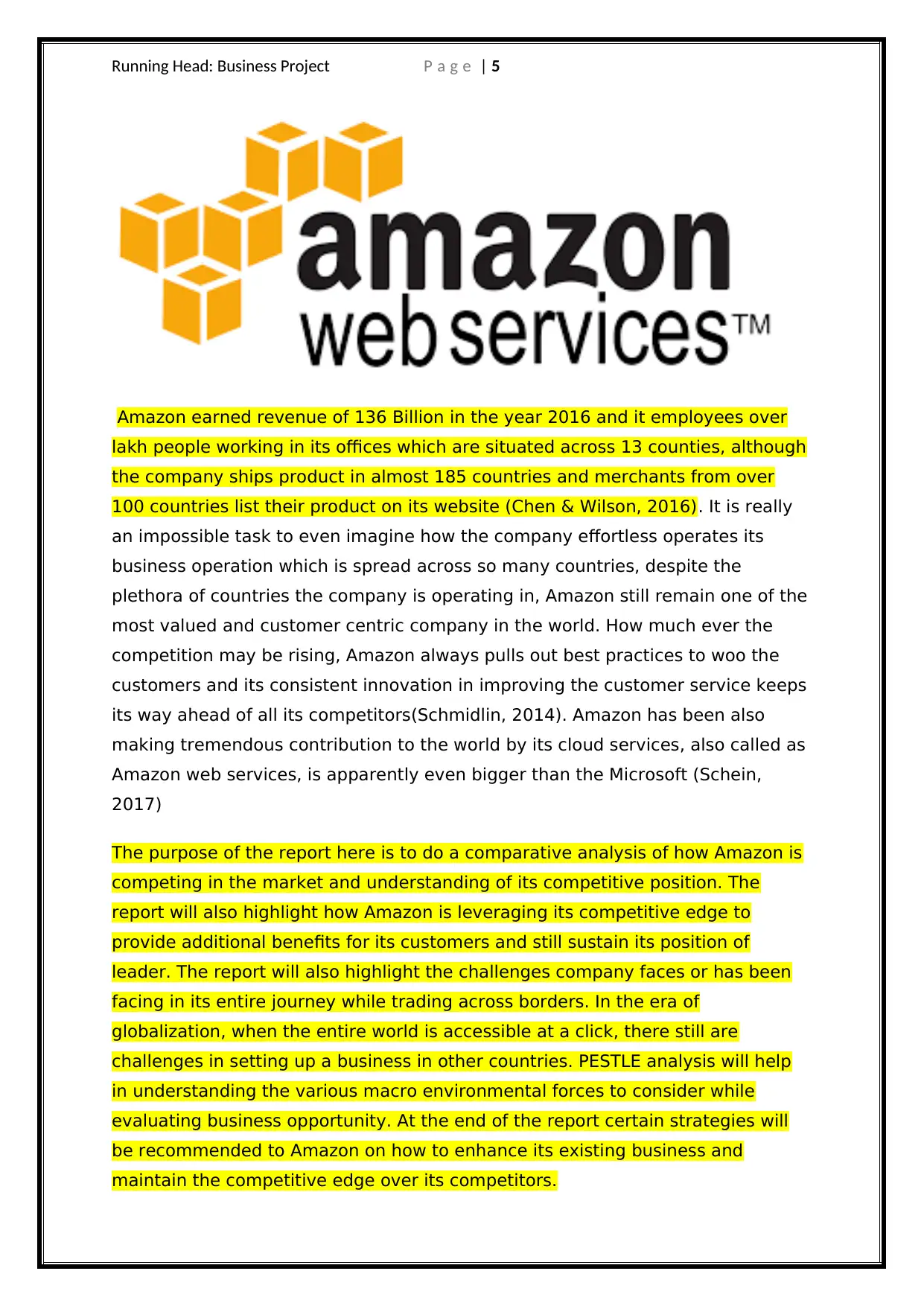
Running Head: Business Project P a g e | 5
Amazon earned revenue of 136 Billion in the year 2016 and it employees over
lakh people working in its offices which are situated across 13 counties, although
the company ships product in almost 185 countries and merchants from over
100 countries list their product on its website (Chen & Wilson, 2016). It is really
an impossible task to even imagine how the company effortless operates its
business operation which is spread across so many countries, despite the
plethora of countries the company is operating in, Amazon still remain one of the
most valued and customer centric company in the world. How much ever the
competition may be rising, Amazon always pulls out best practices to woo the
customers and its consistent innovation in improving the customer service keeps
its way ahead of all its competitors(Schmidlin, 2014). Amazon has been also
making tremendous contribution to the world by its cloud services, also called as
Amazon web services, is apparently even bigger than the Microsoft (Schein,
2017)
The purpose of the report here is to do a comparative analysis of how Amazon is
competing in the market and understanding of its competitive position. The
report will also highlight how Amazon is leveraging its competitive edge to
provide additional benefits for its customers and still sustain its position of
leader. The report will also highlight the challenges company faces or has been
facing in its entire journey while trading across borders. In the era of
globalization, when the entire world is accessible at a click, there still are
challenges in setting up a business in other countries. PESTLE analysis will help
in understanding the various macro environmental forces to consider while
evaluating business opportunity. At the end of the report certain strategies will
be recommended to Amazon on how to enhance its existing business and
maintain the competitive edge over its competitors.
Amazon earned revenue of 136 Billion in the year 2016 and it employees over
lakh people working in its offices which are situated across 13 counties, although
the company ships product in almost 185 countries and merchants from over
100 countries list their product on its website (Chen & Wilson, 2016). It is really
an impossible task to even imagine how the company effortless operates its
business operation which is spread across so many countries, despite the
plethora of countries the company is operating in, Amazon still remain one of the
most valued and customer centric company in the world. How much ever the
competition may be rising, Amazon always pulls out best practices to woo the
customers and its consistent innovation in improving the customer service keeps
its way ahead of all its competitors(Schmidlin, 2014). Amazon has been also
making tremendous contribution to the world by its cloud services, also called as
Amazon web services, is apparently even bigger than the Microsoft (Schein,
2017)
The purpose of the report here is to do a comparative analysis of how Amazon is
competing in the market and understanding of its competitive position. The
report will also highlight how Amazon is leveraging its competitive edge to
provide additional benefits for its customers and still sustain its position of
leader. The report will also highlight the challenges company faces or has been
facing in its entire journey while trading across borders. In the era of
globalization, when the entire world is accessible at a click, there still are
challenges in setting up a business in other countries. PESTLE analysis will help
in understanding the various macro environmental forces to consider while
evaluating business opportunity. At the end of the report certain strategies will
be recommended to Amazon on how to enhance its existing business and
maintain the competitive edge over its competitors.
⊘ This is a preview!⊘
Do you want full access?
Subscribe today to unlock all pages.

Trusted by 1+ million students worldwide
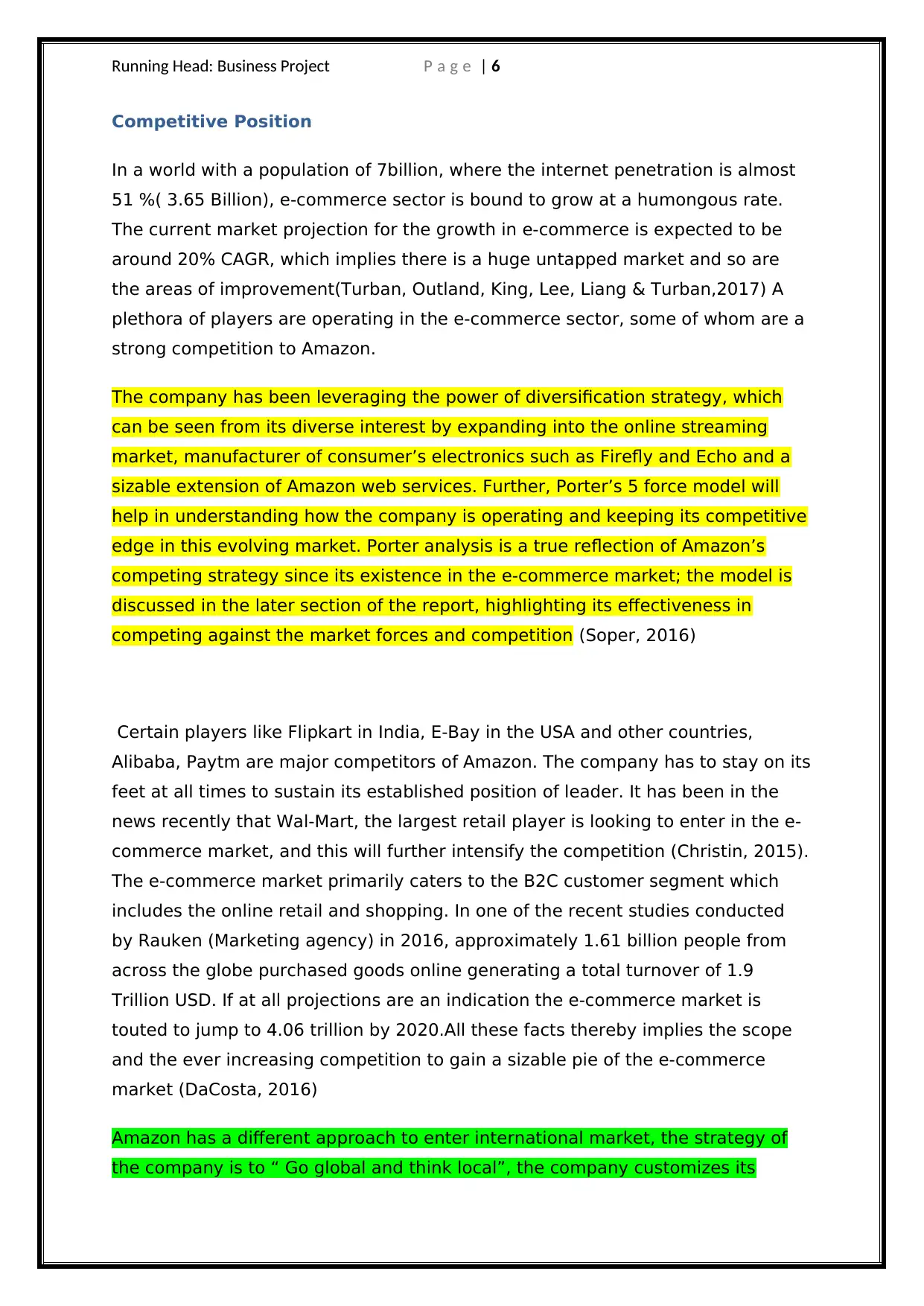
Running Head: Business Project P a g e | 6
Competitive Position
In a world with a population of 7billion, where the internet penetration is almost
51 %( 3.65 Billion), e-commerce sector is bound to grow at a humongous rate.
The current market projection for the growth in e-commerce is expected to be
around 20% CAGR, which implies there is a huge untapped market and so are
the areas of improvement(Turban, Outland, King, Lee, Liang & Turban,2017) A
plethora of players are operating in the e-commerce sector, some of whom are a
strong competition to Amazon.
The company has been leveraging the power of diversification strategy, which
can be seen from its diverse interest by expanding into the online streaming
market, manufacturer of consumer’s electronics such as Firefly and Echo and a
sizable extension of Amazon web services. Further, Porter’s 5 force model will
help in understanding how the company is operating and keeping its competitive
edge in this evolving market. Porter analysis is a true reflection of Amazon’s
competing strategy since its existence in the e-commerce market; the model is
discussed in the later section of the report, highlighting its effectiveness in
competing against the market forces and competition (Soper, 2016)
Certain players like Flipkart in India, E-Bay in the USA and other countries,
Alibaba, Paytm are major competitors of Amazon. The company has to stay on its
feet at all times to sustain its established position of leader. It has been in the
news recently that Wal-Mart, the largest retail player is looking to enter in the e-
commerce market, and this will further intensify the competition (Christin, 2015).
The e-commerce market primarily caters to the B2C customer segment which
includes the online retail and shopping. In one of the recent studies conducted
by Rauken (Marketing agency) in 2016, approximately 1.61 billion people from
across the globe purchased goods online generating a total turnover of 1.9
Trillion USD. If at all projections are an indication the e-commerce market is
touted to jump to 4.06 trillion by 2020.All these facts thereby implies the scope
and the ever increasing competition to gain a sizable pie of the e-commerce
market (DaCosta, 2016)
Amazon has a different approach to enter international market, the strategy of
the company is to “ Go global and think local”, the company customizes its
Competitive Position
In a world with a population of 7billion, where the internet penetration is almost
51 %( 3.65 Billion), e-commerce sector is bound to grow at a humongous rate.
The current market projection for the growth in e-commerce is expected to be
around 20% CAGR, which implies there is a huge untapped market and so are
the areas of improvement(Turban, Outland, King, Lee, Liang & Turban,2017) A
plethora of players are operating in the e-commerce sector, some of whom are a
strong competition to Amazon.
The company has been leveraging the power of diversification strategy, which
can be seen from its diverse interest by expanding into the online streaming
market, manufacturer of consumer’s electronics such as Firefly and Echo and a
sizable extension of Amazon web services. Further, Porter’s 5 force model will
help in understanding how the company is operating and keeping its competitive
edge in this evolving market. Porter analysis is a true reflection of Amazon’s
competing strategy since its existence in the e-commerce market; the model is
discussed in the later section of the report, highlighting its effectiveness in
competing against the market forces and competition (Soper, 2016)
Certain players like Flipkart in India, E-Bay in the USA and other countries,
Alibaba, Paytm are major competitors of Amazon. The company has to stay on its
feet at all times to sustain its established position of leader. It has been in the
news recently that Wal-Mart, the largest retail player is looking to enter in the e-
commerce market, and this will further intensify the competition (Christin, 2015).
The e-commerce market primarily caters to the B2C customer segment which
includes the online retail and shopping. In one of the recent studies conducted
by Rauken (Marketing agency) in 2016, approximately 1.61 billion people from
across the globe purchased goods online generating a total turnover of 1.9
Trillion USD. If at all projections are an indication the e-commerce market is
touted to jump to 4.06 trillion by 2020.All these facts thereby implies the scope
and the ever increasing competition to gain a sizable pie of the e-commerce
market (DaCosta, 2016)
Amazon has a different approach to enter international market, the strategy of
the company is to “ Go global and think local”, the company customizes its
Paraphrase This Document
Need a fresh take? Get an instant paraphrase of this document with our AI Paraphraser
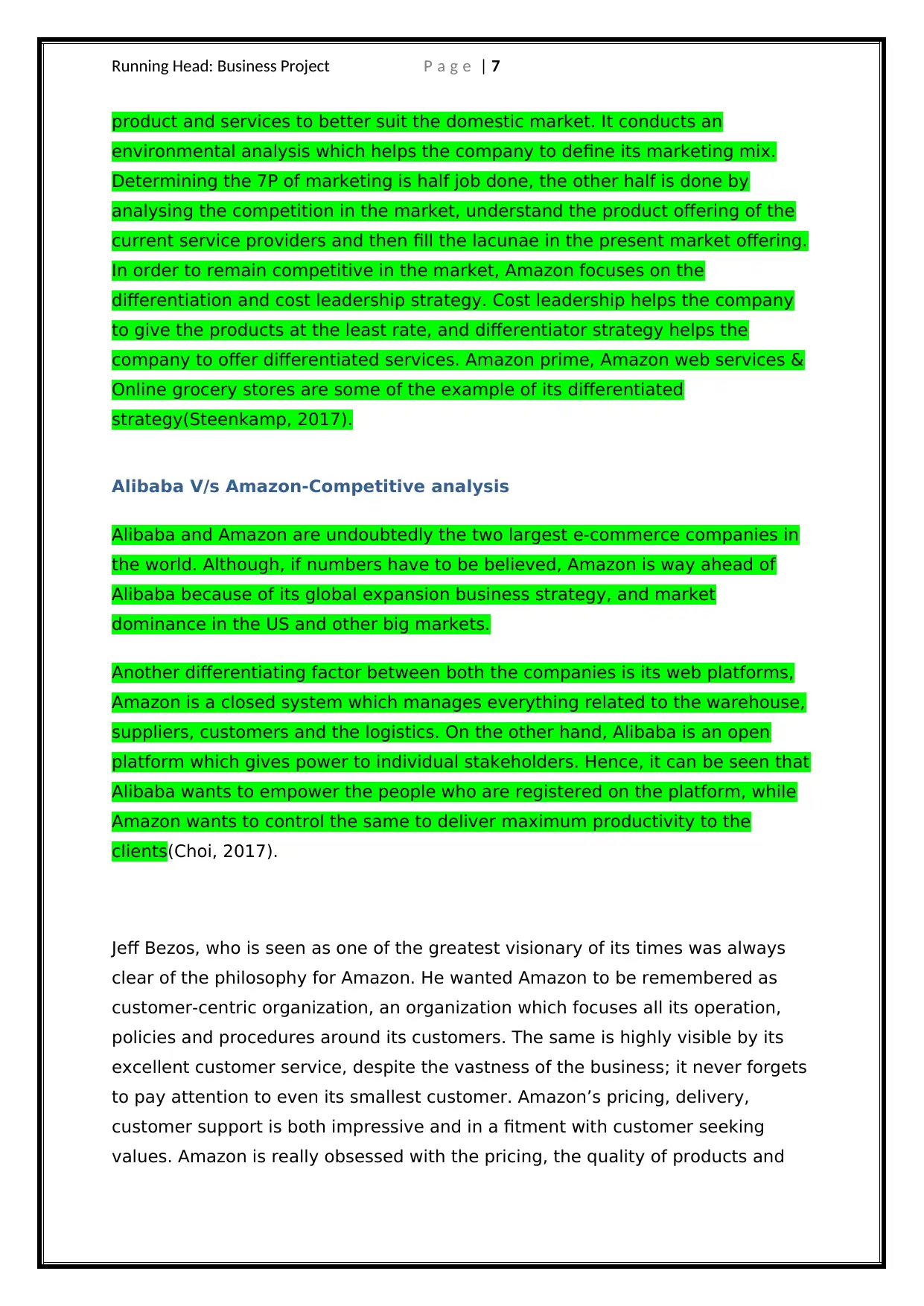
Running Head: Business Project P a g e | 7
product and services to better suit the domestic market. It conducts an
environmental analysis which helps the company to define its marketing mix.
Determining the 7P of marketing is half job done, the other half is done by
analysing the competition in the market, understand the product offering of the
current service providers and then fill the lacunae in the present market offering.
In order to remain competitive in the market, Amazon focuses on the
differentiation and cost leadership strategy. Cost leadership helps the company
to give the products at the least rate, and differentiator strategy helps the
company to offer differentiated services. Amazon prime, Amazon web services &
Online grocery stores are some of the example of its differentiated
strategy(Steenkamp, 2017).
Alibaba V/s Amazon-Competitive analysis
Alibaba and Amazon are undoubtedly the two largest e-commerce companies in
the world. Although, if numbers have to be believed, Amazon is way ahead of
Alibaba because of its global expansion business strategy, and market
dominance in the US and other big markets.
Another differentiating factor between both the companies is its web platforms,
Amazon is a closed system which manages everything related to the warehouse,
suppliers, customers and the logistics. On the other hand, Alibaba is an open
platform which gives power to individual stakeholders. Hence, it can be seen that
Alibaba wants to empower the people who are registered on the platform, while
Amazon wants to control the same to deliver maximum productivity to the
clients(Choi, 2017).
Jeff Bezos, who is seen as one of the greatest visionary of its times was always
clear of the philosophy for Amazon. He wanted Amazon to be remembered as
customer-centric organization, an organization which focuses all its operation,
policies and procedures around its customers. The same is highly visible by its
excellent customer service, despite the vastness of the business; it never forgets
to pay attention to even its smallest customer. Amazon’s pricing, delivery,
customer support is both impressive and in a fitment with customer seeking
values. Amazon is really obsessed with the pricing, the quality of products and
product and services to better suit the domestic market. It conducts an
environmental analysis which helps the company to define its marketing mix.
Determining the 7P of marketing is half job done, the other half is done by
analysing the competition in the market, understand the product offering of the
current service providers and then fill the lacunae in the present market offering.
In order to remain competitive in the market, Amazon focuses on the
differentiation and cost leadership strategy. Cost leadership helps the company
to give the products at the least rate, and differentiator strategy helps the
company to offer differentiated services. Amazon prime, Amazon web services &
Online grocery stores are some of the example of its differentiated
strategy(Steenkamp, 2017).
Alibaba V/s Amazon-Competitive analysis
Alibaba and Amazon are undoubtedly the two largest e-commerce companies in
the world. Although, if numbers have to be believed, Amazon is way ahead of
Alibaba because of its global expansion business strategy, and market
dominance in the US and other big markets.
Another differentiating factor between both the companies is its web platforms,
Amazon is a closed system which manages everything related to the warehouse,
suppliers, customers and the logistics. On the other hand, Alibaba is an open
platform which gives power to individual stakeholders. Hence, it can be seen that
Alibaba wants to empower the people who are registered on the platform, while
Amazon wants to control the same to deliver maximum productivity to the
clients(Choi, 2017).
Jeff Bezos, who is seen as one of the greatest visionary of its times was always
clear of the philosophy for Amazon. He wanted Amazon to be remembered as
customer-centric organization, an organization which focuses all its operation,
policies and procedures around its customers. The same is highly visible by its
excellent customer service, despite the vastness of the business; it never forgets
to pay attention to even its smallest customer. Amazon’s pricing, delivery,
customer support is both impressive and in a fitment with customer seeking
values. Amazon is really obsessed with the pricing, the quality of products and
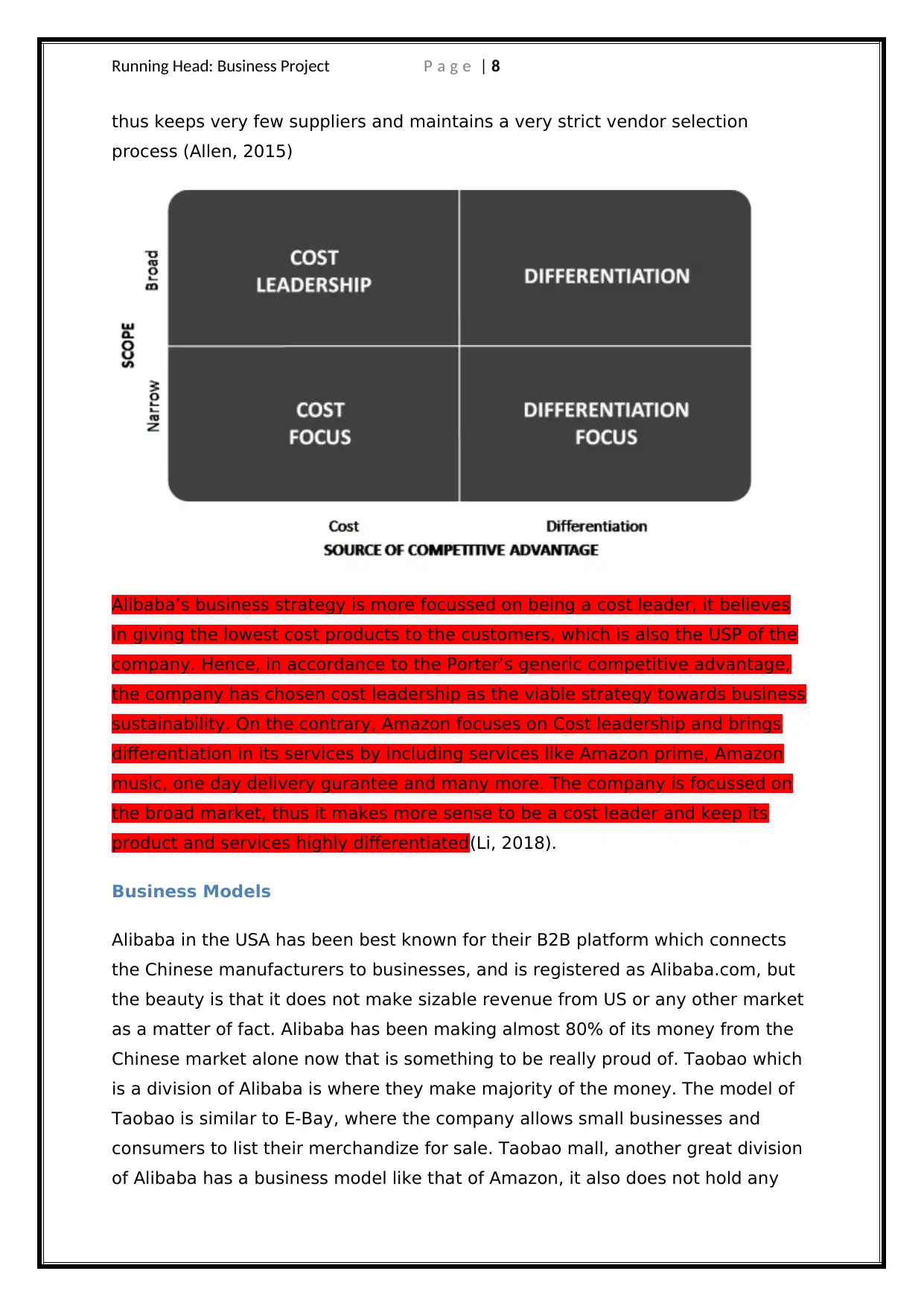
Running Head: Business Project P a g e | 8
thus keeps very few suppliers and maintains a very strict vendor selection
process (Allen, 2015)
Alibaba’s business strategy is more focussed on being a cost leader, it believes
in giving the lowest cost products to the customers, which is also the USP of the
company. Hence, in accordance to the Porter’s generic competitive advantage,
the company has chosen cost leadership as the viable strategy towards business
sustainability. On the contrary, Amazon focuses on Cost leadership and brings
differentiation in its services by including services like Amazon prime, Amazon
music, one day delivery gurantee and many more. The company is focussed on
the broad market, thus it makes more sense to be a cost leader and keep its
product and services highly differentiated(Li, 2018).
Business Models
Alibaba in the USA has been best known for their B2B platform which connects
the Chinese manufacturers to businesses, and is registered as Alibaba.com, but
the beauty is that it does not make sizable revenue from US or any other market
as a matter of fact. Alibaba has been making almost 80% of its money from the
Chinese market alone now that is something to be really proud of. Taobao which
is a division of Alibaba is where they make majority of the money. The model of
Taobao is similar to E-Bay, where the company allows small businesses and
consumers to list their merchandize for sale. Taobao mall, another great division
of Alibaba has a business model like that of Amazon, it also does not hold any
thus keeps very few suppliers and maintains a very strict vendor selection
process (Allen, 2015)
Alibaba’s business strategy is more focussed on being a cost leader, it believes
in giving the lowest cost products to the customers, which is also the USP of the
company. Hence, in accordance to the Porter’s generic competitive advantage,
the company has chosen cost leadership as the viable strategy towards business
sustainability. On the contrary, Amazon focuses on Cost leadership and brings
differentiation in its services by including services like Amazon prime, Amazon
music, one day delivery gurantee and many more. The company is focussed on
the broad market, thus it makes more sense to be a cost leader and keep its
product and services highly differentiated(Li, 2018).
Business Models
Alibaba in the USA has been best known for their B2B platform which connects
the Chinese manufacturers to businesses, and is registered as Alibaba.com, but
the beauty is that it does not make sizable revenue from US or any other market
as a matter of fact. Alibaba has been making almost 80% of its money from the
Chinese market alone now that is something to be really proud of. Taobao which
is a division of Alibaba is where they make majority of the money. The model of
Taobao is similar to E-Bay, where the company allows small businesses and
consumers to list their merchandize for sale. Taobao mall, another great division
of Alibaba has a business model like that of Amazon, it also does not hold any
⊘ This is a preview!⊘
Do you want full access?
Subscribe today to unlock all pages.

Trusted by 1+ million students worldwide
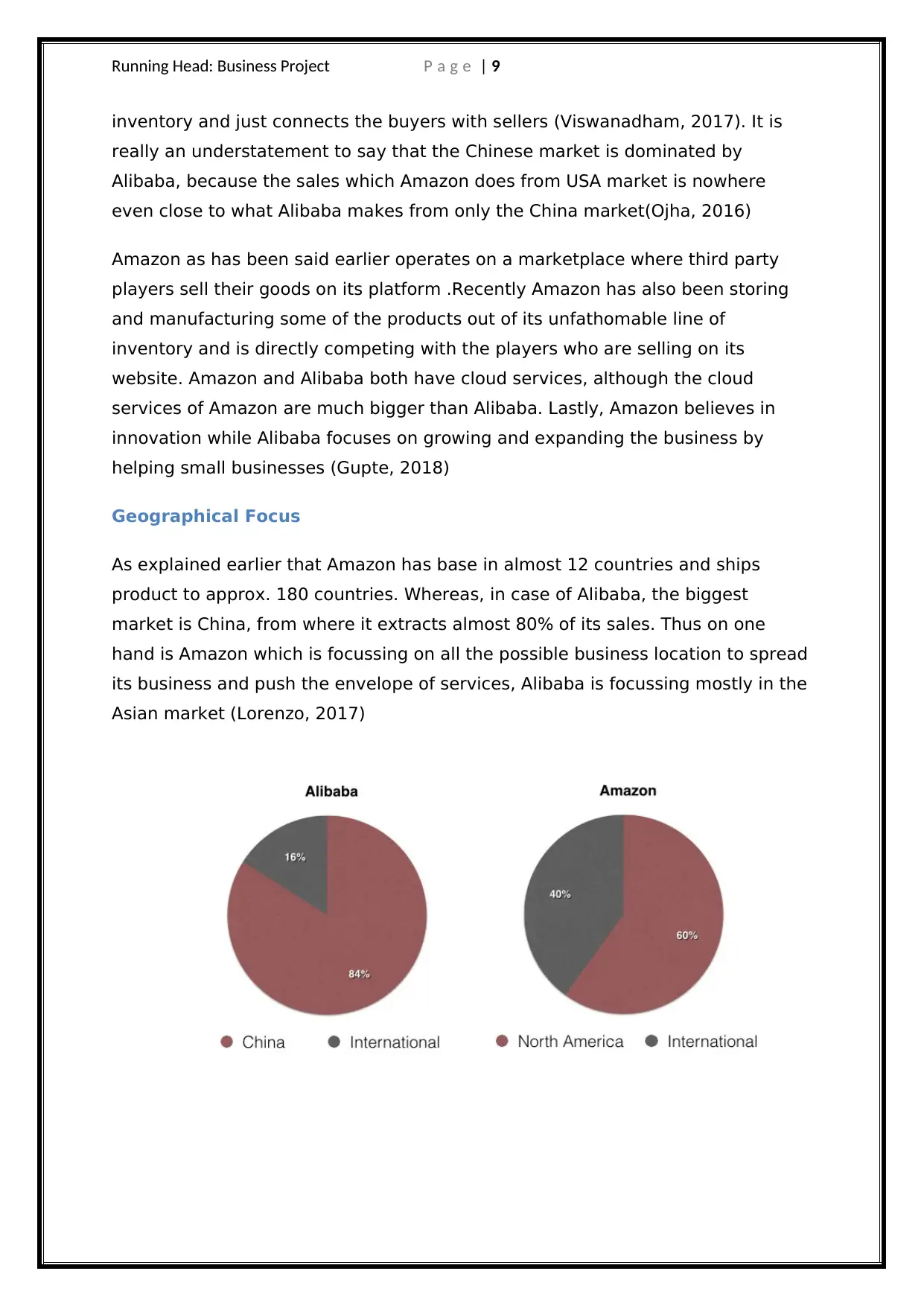
Running Head: Business Project P a g e | 9
inventory and just connects the buyers with sellers (Viswanadham, 2017). It is
really an understatement to say that the Chinese market is dominated by
Alibaba, because the sales which Amazon does from USA market is nowhere
even close to what Alibaba makes from only the China market(Ojha, 2016)
Amazon as has been said earlier operates on a marketplace where third party
players sell their goods on its platform .Recently Amazon has also been storing
and manufacturing some of the products out of its unfathomable line of
inventory and is directly competing with the players who are selling on its
website. Amazon and Alibaba both have cloud services, although the cloud
services of Amazon are much bigger than Alibaba. Lastly, Amazon believes in
innovation while Alibaba focuses on growing and expanding the business by
helping small businesses (Gupte, 2018)
Geographical Focus
As explained earlier that Amazon has base in almost 12 countries and ships
product to approx. 180 countries. Whereas, in case of Alibaba, the biggest
market is China, from where it extracts almost 80% of its sales. Thus on one
hand is Amazon which is focussing on all the possible business location to spread
its business and push the envelope of services, Alibaba is focussing mostly in the
Asian market (Lorenzo, 2017)
inventory and just connects the buyers with sellers (Viswanadham, 2017). It is
really an understatement to say that the Chinese market is dominated by
Alibaba, because the sales which Amazon does from USA market is nowhere
even close to what Alibaba makes from only the China market(Ojha, 2016)
Amazon as has been said earlier operates on a marketplace where third party
players sell their goods on its platform .Recently Amazon has also been storing
and manufacturing some of the products out of its unfathomable line of
inventory and is directly competing with the players who are selling on its
website. Amazon and Alibaba both have cloud services, although the cloud
services of Amazon are much bigger than Alibaba. Lastly, Amazon believes in
innovation while Alibaba focuses on growing and expanding the business by
helping small businesses (Gupte, 2018)
Geographical Focus
As explained earlier that Amazon has base in almost 12 countries and ships
product to approx. 180 countries. Whereas, in case of Alibaba, the biggest
market is China, from where it extracts almost 80% of its sales. Thus on one
hand is Amazon which is focussing on all the possible business location to spread
its business and push the envelope of services, Alibaba is focussing mostly in the
Asian market (Lorenzo, 2017)
Paraphrase This Document
Need a fresh take? Get an instant paraphrase of this document with our AI Paraphraser

Running Head: Business Project P a g e | 10
Product Sales
Alibaba’s revenue in the year 2016 soared to a new high; this new record can be
contributed to the zeal of Chinese buyers, who have been buying almost
everything online. Alibaba saw an increase of 56% in its revenue to reach 22.96
Billion USD. The increasing revenue does not necessarily means that the
company is in profit; it reported a loss of 9.9 billion Yuan, approximately more
than double from last year (Baba, 2016) The Company though increased the
number of consumers on its platform and has added few more Asian countries as
a part of its momentum regime. The company has also exceled at its cloud
services, adding more than 500 million new customers (Kaplan & Montiel, 2016)
Amazon made revenue of 136 Billion USD and despite making losses in the new
markets such as India, the company is steadily moving into a profit zone. The
goods sold on the website have been increased by a margin of 30% and a
considerable number of buyers have also increased (Rossman, 2016). Amazon
web services can also be seen as a pillar of strength for Amazon; it has been
spinning money for the company and is the largest player in cloud services.
However, if the number of product sales have to be seen, Amazon has not yet
disclosed the number of product which is sold in the year 2016, however revenue
wise the company is much ahead of Alibaba(Yenni, Pan & Cui,2017)
Service and Fee revenues
Both Amazon and Alibaba work on a commission model, they charge the sellers
for every transaction which happens through their website. ALibaba despite
charging commission to the sellers also earns revenue through Google ads. On
the other hand, Amazon earns its revenue only from seller’s commission and by
selling its own good on the website (Chen, 2014)
ALibaba charges somewhere between 3-5% as commission fee, whereas in case
of Amazon the commission ranges somewhere between 6% to 20%. Hence, it
can be said that Amazon makes more money in comparison to Alibaba, which is
then further utilized in improving its customer service (Khammuang, 2015)
Road Ahead
There are no two doubts that it is a matter of time when both these giants will
clash head on. Alibaba dominates the China market and Amazon is the
Product Sales
Alibaba’s revenue in the year 2016 soared to a new high; this new record can be
contributed to the zeal of Chinese buyers, who have been buying almost
everything online. Alibaba saw an increase of 56% in its revenue to reach 22.96
Billion USD. The increasing revenue does not necessarily means that the
company is in profit; it reported a loss of 9.9 billion Yuan, approximately more
than double from last year (Baba, 2016) The Company though increased the
number of consumers on its platform and has added few more Asian countries as
a part of its momentum regime. The company has also exceled at its cloud
services, adding more than 500 million new customers (Kaplan & Montiel, 2016)
Amazon made revenue of 136 Billion USD and despite making losses in the new
markets such as India, the company is steadily moving into a profit zone. The
goods sold on the website have been increased by a margin of 30% and a
considerable number of buyers have also increased (Rossman, 2016). Amazon
web services can also be seen as a pillar of strength for Amazon; it has been
spinning money for the company and is the largest player in cloud services.
However, if the number of product sales have to be seen, Amazon has not yet
disclosed the number of product which is sold in the year 2016, however revenue
wise the company is much ahead of Alibaba(Yenni, Pan & Cui,2017)
Service and Fee revenues
Both Amazon and Alibaba work on a commission model, they charge the sellers
for every transaction which happens through their website. ALibaba despite
charging commission to the sellers also earns revenue through Google ads. On
the other hand, Amazon earns its revenue only from seller’s commission and by
selling its own good on the website (Chen, 2014)
ALibaba charges somewhere between 3-5% as commission fee, whereas in case
of Amazon the commission ranges somewhere between 6% to 20%. Hence, it
can be said that Amazon makes more money in comparison to Alibaba, which is
then further utilized in improving its customer service (Khammuang, 2015)
Road Ahead
There are no two doubts that it is a matter of time when both these giants will
clash head on. Alibaba dominates the China market and Amazon is the
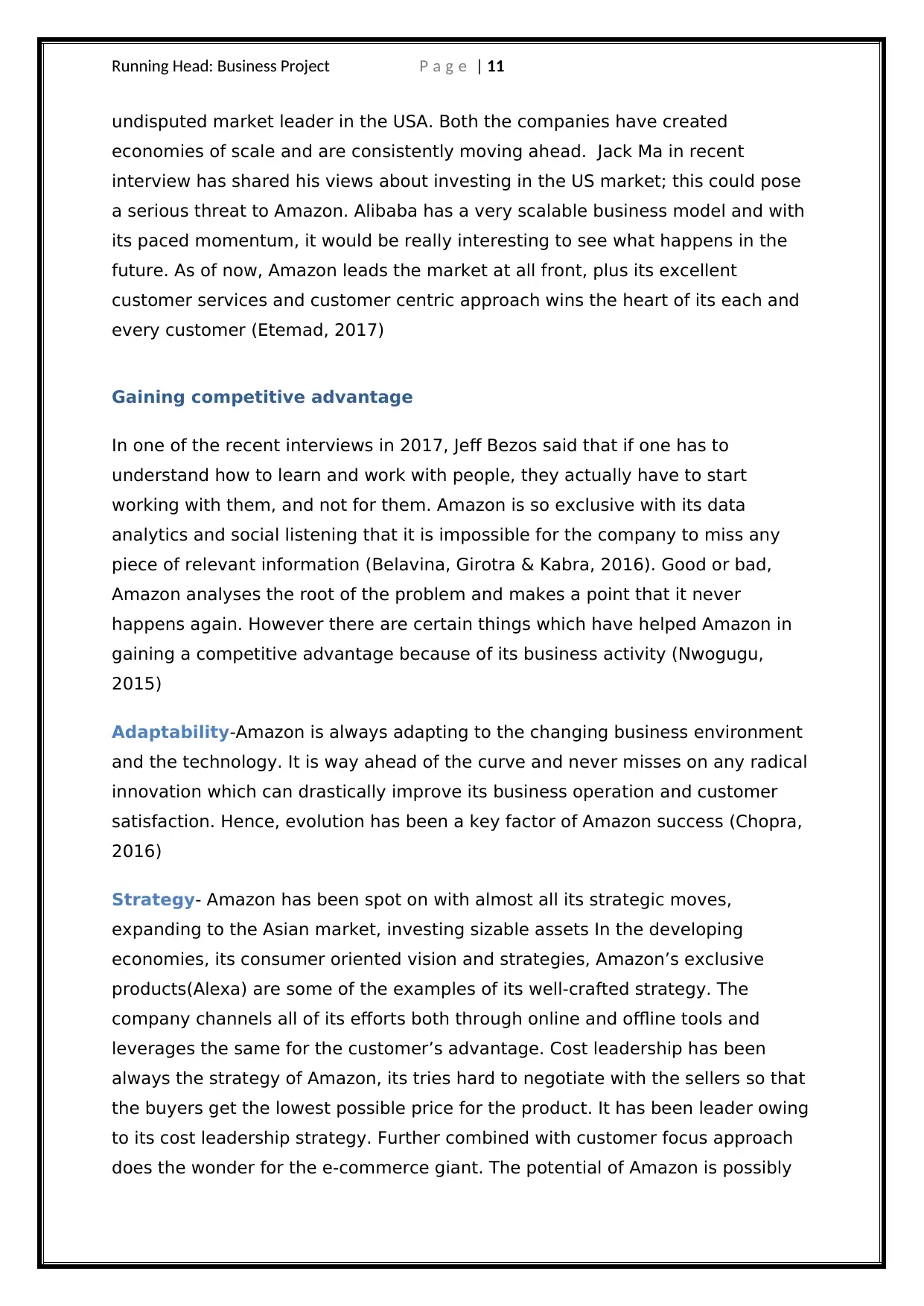
Running Head: Business Project P a g e | 11
undisputed market leader in the USA. Both the companies have created
economies of scale and are consistently moving ahead. Jack Ma in recent
interview has shared his views about investing in the US market; this could pose
a serious threat to Amazon. Alibaba has a very scalable business model and with
its paced momentum, it would be really interesting to see what happens in the
future. As of now, Amazon leads the market at all front, plus its excellent
customer services and customer centric approach wins the heart of its each and
every customer (Etemad, 2017)
Gaining competitive advantage
In one of the recent interviews in 2017, Jeff Bezos said that if one has to
understand how to learn and work with people, they actually have to start
working with them, and not for them. Amazon is so exclusive with its data
analytics and social listening that it is impossible for the company to miss any
piece of relevant information (Belavina, Girotra & Kabra, 2016). Good or bad,
Amazon analyses the root of the problem and makes a point that it never
happens again. However there are certain things which have helped Amazon in
gaining a competitive advantage because of its business activity (Nwogugu,
2015)
Adaptability-Amazon is always adapting to the changing business environment
and the technology. It is way ahead of the curve and never misses on any radical
innovation which can drastically improve its business operation and customer
satisfaction. Hence, evolution has been a key factor of Amazon success (Chopra,
2016)
Strategy- Amazon has been spot on with almost all its strategic moves,
expanding to the Asian market, investing sizable assets In the developing
economies, its consumer oriented vision and strategies, Amazon’s exclusive
products(Alexa) are some of the examples of its well-crafted strategy. The
company channels all of its efforts both through online and offline tools and
leverages the same for the customer’s advantage. Cost leadership has been
always the strategy of Amazon, its tries hard to negotiate with the sellers so that
the buyers get the lowest possible price for the product. It has been leader owing
to its cost leadership strategy. Further combined with customer focus approach
does the wonder for the e-commerce giant. The potential of Amazon is possibly
undisputed market leader in the USA. Both the companies have created
economies of scale and are consistently moving ahead. Jack Ma in recent
interview has shared his views about investing in the US market; this could pose
a serious threat to Amazon. Alibaba has a very scalable business model and with
its paced momentum, it would be really interesting to see what happens in the
future. As of now, Amazon leads the market at all front, plus its excellent
customer services and customer centric approach wins the heart of its each and
every customer (Etemad, 2017)
Gaining competitive advantage
In one of the recent interviews in 2017, Jeff Bezos said that if one has to
understand how to learn and work with people, they actually have to start
working with them, and not for them. Amazon is so exclusive with its data
analytics and social listening that it is impossible for the company to miss any
piece of relevant information (Belavina, Girotra & Kabra, 2016). Good or bad,
Amazon analyses the root of the problem and makes a point that it never
happens again. However there are certain things which have helped Amazon in
gaining a competitive advantage because of its business activity (Nwogugu,
2015)
Adaptability-Amazon is always adapting to the changing business environment
and the technology. It is way ahead of the curve and never misses on any radical
innovation which can drastically improve its business operation and customer
satisfaction. Hence, evolution has been a key factor of Amazon success (Chopra,
2016)
Strategy- Amazon has been spot on with almost all its strategic moves,
expanding to the Asian market, investing sizable assets In the developing
economies, its consumer oriented vision and strategies, Amazon’s exclusive
products(Alexa) are some of the examples of its well-crafted strategy. The
company channels all of its efforts both through online and offline tools and
leverages the same for the customer’s advantage. Cost leadership has been
always the strategy of Amazon, its tries hard to negotiate with the sellers so that
the buyers get the lowest possible price for the product. It has been leader owing
to its cost leadership strategy. Further combined with customer focus approach
does the wonder for the e-commerce giant. The potential of Amazon is possibly
⊘ This is a preview!⊘
Do you want full access?
Subscribe today to unlock all pages.

Trusted by 1+ million students worldwide
1 out of 26
Related Documents
Your All-in-One AI-Powered Toolkit for Academic Success.
+13062052269
info@desklib.com
Available 24*7 on WhatsApp / Email
![[object Object]](/_next/static/media/star-bottom.7253800d.svg)
Unlock your academic potential
Copyright © 2020–2025 A2Z Services. All Rights Reserved. Developed and managed by ZUCOL.





